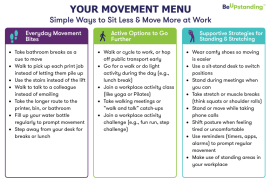In a typical week in the office, workers on average can spend 30 hours of their workday sitting, with much of this accrued in prolonged, unbroken bouts. Sedentary behaviours, such as sitting, increases ‘bad’ cholesterol (LDL–C), decreases ‘good’ cholesterol (HDL–C) levels and increases the risk of abnormal glucose metabolism. These physiological markers can contribute to an increased risk of cancer, cardiovascular disease mortality, and diabetes. Previous studies have found that regularly breaking up prolonged sitting with activity breaks can have benefit for these indicators of cardiometabolic health in a laboratory setting. However, the impacts of regular breaks in an office setting are less clear.

One simple way to increase breaks in prolonged sitting is to schedule short 2-minute activity breaks throughout the day by climbing stairs. A recent pilot study published in BMC Public Health Journal investigated the feasibility of introducing prompted stair climbing exercise breaks into the workplace and assessed any resulting improvements in glucose and cholesterol levels. It also evaluated the acceptability of such activity as an interruption of their work.
What was done?
Over eight weeks, 16 sedentary office workers from the United Kingdom (five females) took part in this quasi-experimental research study. Blood samples were taken from all participants before and after the trial to measure the effects of the intervention on cholesterol and glucose levels.
Participants were evenly divided into either the intervention group or the control group. Participants in the control group were asked to go about their day as usual. Participants in the intervention group were given computer prompts every hour, eight times per day, over the eight-hour working day, with the prompts encouraging them to go up then down four flights of stairs (32 flights per day, 160 flights per five-day workweek). Intervention participants were asked to wear a pedometer for the duration of the study to record the number of steps they took per week. They were also given a log sheet to record the number of floors climbed following each prompt. Participants from the intervention group were also interviewed at the end of the 8-week trial to understand factors relating to the acceptability of the intervention.
What was found?
The intervention group climbed an average of 121 floors per week or 24 floors a day. The breaks took up an average of 16 minutes of their daily working hours without any compensatory reduction in the participants’ usual step counts. The intervention group had a greater reduction in fasting blood glucose and ‘bad’ cholesterol (LDL–C) levels than the control group. Results from the interviews revealed that most participants from the intervention group reported positive health effects (75%) from the eight-week exercise intervention and considered climbing stairs easy to complete, convenient and beneficial to their work. Most participants stated they intend to continue climbing stairs on a regular basis.

Collectively, the findings suggest that a regular prompt to climb stairs is a feasible, cost-effective and acceptable approach for breaking up prolonged sedentary time in office workers. This strategy may be particularly beneficial to workers who are mobile, who work in a building with more than four-stories, who have long hours of sitting time their desk, and who wish to improve their health.
What is the importance of these findings?
The findings have important implications. According to the WHO, globally, the top three causes of death in 2019 are ischaemic heart disease, stroke, and chronic obstructive pulmonary disease. Encouraging Australian companies to schedule short 2-minute activity breaks for employees throughout the day may be one way to help offset the negative consequences of long periods of sitting, potentially leading to a decrease in cardiovascular disease, obesity and type 2 diabetes.
Click here to read the full journal article.
This article was written by Eugeenia Wen and Chan Hi Yue Yoyo, as a part of the 2022 Summer Research Scholarship Program conducted with the Health and Wellbeing Centre for Research Innovation
![]()










Comments are closed.